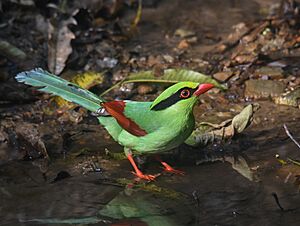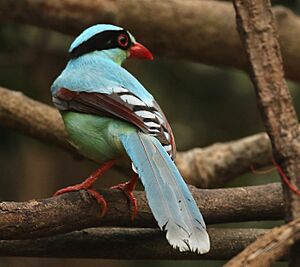Common green magpie facts for kids
Quick facts for kids Common green magpie |
|
|---|---|
 |
|
| Nominate subspecies | |
| Conservation status | |
| Scientific classification | |
| Genus: |
Cissa
|
| Species: |
chinensis
|
 |
|
| Native distribution of the common green magpie |
|
The common green magpie (Cissa chinensis) is a beautiful bird from the crow family. It's about the same size as a Eurasian jay or a little smaller. These birds are known for their bright, lush green feathers. Sometimes, if they are kept in captivity or don't eat well, their green color can fade to a bluish-turquoise.
You can spot a common green magpie by its thick black stripe that goes from its beak, through its eyes, and all the way to the back of its head. It has a long tail with white tips. Its bright red eye rims, beak, and legs stand out against its green body. Even its wings are a reddish-maroon color!
Contents
Where Do Green Magpies Live?
These amazing birds live in Asia. You can find them in the lower Himalayas in northeastern India. Their home stretches in a wide band southeast into central Thailand, Malaysia, Sumatra, and northwestern Borneo.
They prefer to live in evergreen forests, including bamboo forests. You might also see them in clearings or bushy areas.
What Do Green Magpies Eat?
The common green magpie is a clever hunter. It looks for food both on the ground and high up in the trees. Most of its diet is made up of animals.
- They eat lots of different invertebrates, like insects.
- They also hunt small reptiles and tiny mammals.
- Sometimes, they will even eat young birds and their eggs.
- If they find a recently killed animal, they will also eat its meat.
When baby magpies are born, the parents always make sure to feed them first!
Nests and Babies
Green magpies build their nests in trees or large bushes. They often choose spots hidden within tangles of climbing vines. A female magpie usually lays about 4 to 6 eggs.
What Do Green Magpies Sound Like?
These birds have many different calls. Their voice can be quite harsh, often sounding like a loud peep-peep. But they also make whistling and chattering sounds.
About the Green Magpie's Name
The common green magpie is one of four species in a group called Cissa. Its scientific name is Cissa chinensis. The word Cissa comes from an old Greek word for "jay" or "magpie." The name chinensis was given because people first thought the bird came from China, but it actually lives mostly in Southeast Asia.
There are a few slightly different types, or subspecies, of the common green magpie found across its wide home range.



